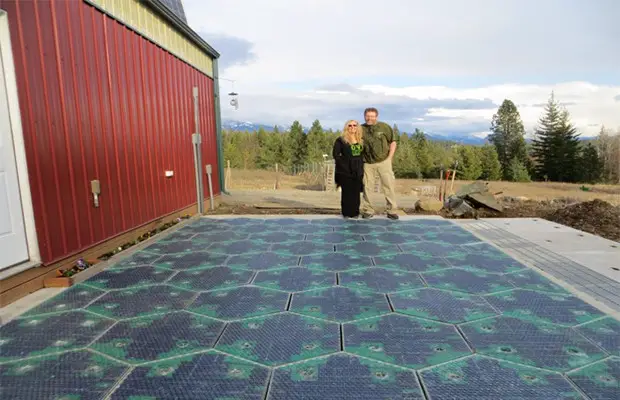About 8 years ago, an electrical engineer and his counselor wife started throwing around an idea to replace asphalt on highways and byways throughout the US with electricity-producing solar panels that were tough enough to be driven upon. The idea blossomed into a project, where the panels featured built-in LEDs that could “paint the road” with markings and warnings, and could be heated to prevent snow and ice build up. The US Federal Highway Administration paid for the couple to produce a working prototype, which they did, and then again to expand the concept into an operational parking lot setup. As the latter contract comes to an end, the Solar Roadways project has released photos of the (almost) completed installation at its Idaho electronics lab. Now the team is dipping into crowd-funding waters with a campaign to raise funds for the move into commercial production.
Many roads, highways, parking lots or driveways can spend much their daytime unused. Sunlight can even break through gridlock to the road below. In 2006, Scott and Julie Brusaw hatched a plan to make use of all that untapped energy by replacing asphalt with toughened PV panels that would also include embedded lighting to act as road markings and driver alerts, as well as communication and power cables to replace overhead lines. The project received funding from the US Dept of Transportation to the tune of US$100,000 in August 2009, and work began on the first proof-of-concept prototype.
By February 2010, the first 12 x 12 ft (3.7 x 3.7 m) road panel (made up of 16 smaller connected panels) was ready, complete with embedded LEDs that could be programmed to deliver custom messages. The proof-of-concept Phase I prototype didn’t include any PV cells and lacked the custom-hardened glass with integrated heating element for the upper face, but it served to demonstrate that the proposed electronics worked as promised. The team also built smaller crosswalk panels featuring load cells to test a pedestrian/wildlife detection mechanism, which would flash instructions to slow down when a weight was detected on the surface.
Around this time, Scott Brusaw was invited to give a TED talk in Sacramento (which is worth a watch as it details much of the project’s inspiration, history and aims), and the project went on to win first prize in two of GE’s Ecomagination challenges.
After entertaining the world media circus for a while, and traveling around the country to deliver talks on the project, funding was secured in June of 2011 for the second phase of development – to create fully functional parking lot.
Work on the electronics began immediately, and a site next to the electronics lab prepared for ground breaking. The Brusaws and their small, but dedicated, team of volunteers revealed a new hexagonal road panel design in July 2013, that would allow them “to handle curves easily and we designed the shape, macro and micro textures for stability, traction, strength.” The first batch of the completed new panels were ready for installation and testing by September.
Spin forward to the end of last month, and the first photos of the now operational Solar Roadwaysparking lot were released. Each of the new panels features PV cells and circuit boards, 128 programmable LEDs, a heating element to help deal with ice and snow, and are topped with “super-strength” textured glass (which has exceeded expectations in load, traction and impact resistance testing).
“Half of our prototype parking lot is mono-crystalline, while the other half is poly-crystalline,” Julie Brusaw told Gizmag. “The parking lot is equivalent to a 3600-watt solar array. The power collected is dependent upon the amount of sunshine received. So as with all solar, it will produce more in some parts of the country and world than others.”
“We’ve moved power and data cables to a Cable Corridor alongside the road/parking lot,” she continued. “This provides easy access the power/data companies. It will give the cables a home and eliminate the need for overhead wires that are unsightly and subject to ice/breakage. The other way the power companies are handling it now is to bury them (sometimes right next to gas lines) in the dirt and dig them up with a shovel for access. So we can make utility companies’ work much easier and safer. Our system can also eliminate cell phone dead spots by installing a ‘leaky’ cable in the Cable Corridor. Our corridor can be a home for all kinds of cables including TV, fiber optic for high speed internet, phone, etc.”
A section in the installation’s Cable Corridor has been included to store, treat and redistribute storm water, and the Brusaws sourced recycled glass and were able to incorporate 10 percent in the aggregate of the base layer of the prototype.
Currently, some 69 percent of the layer directly under the glass of each hexagonal unit is made up of photovoltaic cells, but that will increase to 100 percent prior to commercial production. Before that can happen, though, the Solar Roadways project has hit Indiegogo (starting, appropriately enough, on Earth Day) to help raise enough money to hire a team of engineers and other professionals, streamline the production process and move into manufacturing proper.
A lofty funding target of $1 million has been set, and the project will receive all funding, even if the campaign goal is not met. Rewards include t-shirts, coffee mugs, a backer’s name engraved on one of the prototype’s 396 mounting hole covers, and samples of the toughened glass.
The campaign video below brings the Solar Roadways story bang up to date.
References:
Credits: **This was originally featured on: Gizmag via Expanded Consciousness



No comments:
Post a Comment